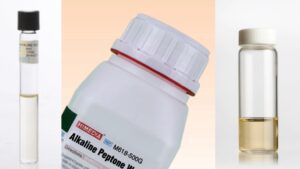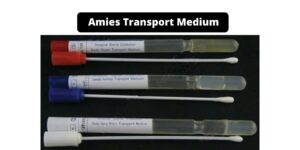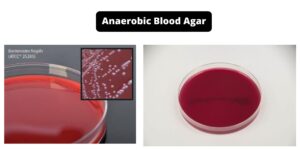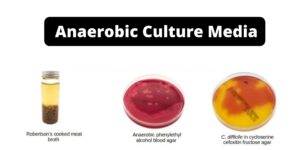What is Starch casein agar (SCA)?
- Starch Casein Agar (SCA) is a specialized nutrient medium used primarily for isolating and cultivating saccharolytic marine bacteria, with a particular focus on Actinomycetes. These bacteria are characterized by their filamentous structures and resemble fungi in appearance. Actinomycetes are Gram-positive and exhibit branching or filamentous morphology. Traditionally isolated from terrestrial environments, recent studies have also highlighted their presence in marine sediments.
- Marine sediments have emerged as a rich source for novel Actinomycetes. These environments are recognized for their potential in yielding new products, including antibiotics and anticancer agents. Actinomycetes play a crucial role in the environment, contributing to the decomposition and transformation of complex organic materials. Thus, they are significant both in environmental recycling processes and in therapeutic applications.
- Starch Casein Agar serves as a conducive environment for the growth of these bacteria. The medium incorporates starch as its primary carbohydrate source, which is essential for the saccharolytic activity of the organisms. The starch in the agar provides necessary nutrients for the bacteria to synthesize proteins and carbohydrates.
- Additionally, SCA includes casein, which supplies amino acids and peptides, further supporting bacterial growth. The medium is enriched with seawater, which contains a variety of nutrients, vitamins, and sea salts that are vital for marine microorganisms. This composition ensures that the medium is well-suited for the cultivation of Actinomycetes from marine sediments and other aquatic sources.
Principle of Starch casein agar (SCA)
- The principle behind Starch Casein Agar (SCA) lies in its ability to support the growth of a diverse range of microorganisms by providing essential nutrients that are not available in standard media like Nutrient Agar. This medium is specifically formulated to cater to the needs of organisms such as Actinomycetes and other marine bacteria that require particular nutrients and supplements.
- The primary components of SCA include starch, casein, and seawater. Each of these constituents plays a distinct role in supporting microbial growth. Starch serves as the principal source of carbon, which is crucial for saccharolytic organisms. These bacteria utilize starch to produce energy and build cellular structures.
- Casein provides a vital source of protein necessary for synthesizing amino acids in bacteria. Additionally, casein contributes various vitamins, trace minerals, organic compounds, and salts that further facilitate bacterial growth and metabolism. This complex nutritional profile supports a wide range of microorganisms that might otherwise be unable to grow on simpler media.
- Seawater is another critical component of SCA. It supplies sea salts that offer complex ionic sources essential for maintaining the osmotic balance of the medium, making it suitable for marine bacteria. Moreover, seawater acts as a buffer, helping to stabilize the pH of the medium during microbial growth, thereby preventing pH fluctuations that could adversely affect bacterial development.
- Distilled water is used to dissolve these nutrients, ensuring that they are readily available for bacterial absorption. Agar, the solidifying agent in the medium, provides a stable surface for microbial growth. This allows for clear observation of colony morphology and enables accurate enumeration of the microorganisms.
Composition of Starch casein agar (SCA)
The composition of Starch Casein Agar (SCA) is meticulously designed to support the growth of a wide range of microorganisms, particularly saccharolytic marine bacteria and Actinomycetes. This medium includes various components that provide essential nutrients and create an optimal environment for microbial growth. The exact composition of SCA can vary slightly depending on the manufacturer, but the general ingredients and their functions are as follows:
- Soluble Starch
- Quantity: 10.0 g/L
- Function: Serves as the primary source of carbon for saccharolytic organisms. Starch is metabolized by bacteria to produce energy and build cellular structures.
- Casein (Vitamin Free)
- Quantity: 0.30 g/L
- Function: Provides essential proteins and amino acids necessary for bacterial growth. Casein also contributes additional vitamins and trace minerals.
- Potassium Nitrate (KNO3)
- Quantity: 2.0 g/L
- Function: Acts as a nitrogen source, which is crucial for protein synthesis and other metabolic processes in bacteria.
- Magnesium Sulfate Heptahydrate (MgSO4·7H2O)
- Quantity: 0.05 g/L
- Function: Supplies magnesium, which is a cofactor for various enzymatic reactions and supports overall bacterial metabolism.
- Potassium Phosphate (K2HPO4)
- Quantity: 2.0 g/L
- Function: Serves as a buffering agent to maintain the medium’s pH and provides essential phosphorus for nucleic acid and ATP synthesis.
- Sodium Chloride (NaCl)
- Quantity: 2.0 g/L
- Function: Maintains osmotic balance and provides essential ions for bacterial growth.
- Calcium Carbonate (CaCO3)
- Quantity: 0.02 g/L
- Function: Acts as a buffering agent to stabilize the pH of the medium and provides calcium, which is important for cell wall stability.
- Iron Sulfate Heptahydrate (FeSO4·7H2O)
- Quantity: 0.01 g/L
- Function: Supplies iron, an essential trace element that functions as a cofactor in various enzymatic processes.
- Agar
- Quantity: 18.0 g/L
- Function: Acts as a solidifying agent, providing a stable surface for microbial growth and allowing for the observation of colony morphology.
Alternative Composition (HiMedia Starch Casein Agar)
- Starch
- Quantity: 10.0 g/L
- Function: Same as above, serving as the primary carbon source.
- Casein
- Quantity: 1.0 g/L
- Function: Provides proteins and amino acids for bacterial growth.
- Seawater
- Quantity: 37.0 mL/L
- Function: Supplies a range of essential nutrients, vitamins, and sea salts, creating a medium suited for marine microorganisms.
- Agar
- Quantity: 15.0 g/L
- Function: Solidifies the medium, supporting bacterial colony formation and morphological observation.
The final pH of Starch Casein Agar is typically maintained around 7.3 ±0.2 for the standard formulation and 7.2 ±0.2 for the HiMedia variant at 25°C. This pH range ensures a stable environment conducive to bacterial growth.
| Ingredient | Quantity (g/L) | Function |
|---|---|---|
| Soluble Starch | 10.0 | Primary carbon source for energy and cellular structure. |
| Casein (Vitamin Free) | 0.30 | Provides proteins, amino acids, and additional vitamins and trace minerals. |
| Potassium Nitrate (KNO3) | 2.0 | Nitrogen source essential for protein synthesis and metabolic processes. |
| Magnesium Sulfate Heptahydrate (MgSO4·7H2O) | 0.05 | Supplies magnesium for enzymatic reactions and overall metabolism. |
| Potassium Phosphate (K2HPO4) | 2.0 | Buffering agent to maintain pH and source of phosphorus for nucleic acid synthesis. |
| Sodium Chloride (NaCl) | 2.0 | Maintains osmotic balance and provides essential ions. |
| Calcium Carbonate (CaCO3) | 0.02 | Buffering agent to stabilize pH and provides calcium for cell wall stability. |
| Iron Sulfate Heptahydrate (FeSO4·7H2O) | 0.01 | Supplies iron as a cofactor for enzymatic processes. |
| Agar | 18.0 | Solidifying agent that provides a stable surface for microbial growth. |
Preparation of Starch casein agar (SCA)
The preparation of Starch Casein Agar (SCA) involves several precise steps to ensure that the medium is correctly formulated and sterile for microbial cultivation. Below is a detailed, step-by-step guide for preparing SCA:
- Preparation of the Suspension
- Combine Ingredients: Measure 63 grams of dehydrated Starch Casein Agar powder. Add this to 1000 milliliters of distilled or deionized water in a beaker.
- Dissolve the Medium: Stir the mixture thoroughly and heat it to boiling. This step ensures that the agar powder fully dissolves, forming a homogeneous suspension.
- Sterilization
- Autoclaving: Transfer the beaker containing the dissolved medium to an autoclave. Sterilize the medium at 15 pounds per square inch (psi) pressure, equivalent to 121°C, for 15 minutes. This process eliminates any potential contaminants and ensures the medium is sterile.
- Cooling and Pouring
- Cool the Medium: After autoclaving, carefully remove the beaker from the autoclave. Allow the medium to cool to a temperature of approximately 40-45°C. This temperature range prevents the agar from solidifying prematurely while still being cool enough for handling.
- Pour into Petri Plates: Under sterile conditions, pour the cooled, liquid medium into sterile Petri dishes. This ensures that the medium is distributed evenly and that the plates are ready for microbial inoculation.
- Post-Preparation
- Drying: Allow the poured media to solidify at room temperature. Once solidified, the plates can be placed in a hot air oven set to a low temperature for a few minutes. This step helps to remove any residual moisture from the surface of the plates, reducing the risk of contamination.
Storage and Shelf Life of Starch casein agar (SCA)
- Storage of Powdered Medium
- Conditions: Store the powdered Starch Casein Agar in a tightly closed container. Keep it in a dry, ventilated area with temperatures ranging from 10 to 30°C. The medium is hygroscopic, so proper storage is essential to prevent moisture absorption and lump formation.
- Protection: Ensure the container is protected from extremes of temperature and sources of ignition to maintain the quality of the powder.
- Storage of Prepared Medium
- Conditions: Store prepared SCA plates at 20-30°C. Keep them in a dry, ventilated area to avoid moisture accumulation and potential contamination.
- Expiry: Use the prepared medium before the expiration date indicated on the label to ensure optimal performance and reliability.
Result Interpretation on Starch casein agar (SCA)
The interpretation of results on SCA is based on the growth and morphology of colonies observed on the medium. Here is a detailed guide for interpreting the results:
- Actinomycetes
- Growth: Luxuriant
- Colony Morphology: Actinomycetes typically form white to light yellow colonies that are powdery in appearance. Within 1-3 days of incubation, colonies may range from circular to pinpoint and exhibit a powdery surface texture, with a mucoid base. By 7 days of incubation, the colonies usually develop a complete powdery texture, reflecting their characteristic morphology and growth pattern on SCA.
- Streptococcus limosus
- Growth: Good-luxuriant
- Colony Morphology: This organism produces smooth, colorless colonies with a diameter between 2-4 mm. The colonies may vary in coloration, but they typically appear smooth and are well-defined. The growth of Streptococcus limosus on SCA indicates its ability to thrive in this medium while exhibiting its specific colony characteristics.
- Streptomyces praecox
- Growth: Good-luxuriant
- Colony Morphology: Streptomyces praecox forms golden yellow, circular, and convex colonies that are smooth and opaque. These colonies generally measure between 2-4 mm in diameter. The distinct golden yellow color and smooth texture are indicative of this species’ growth on SCA, highlighting its ability to produce pigments and thrive in the medium.
- Vibrio cholerae
- Growth: Good-luxuriant
- Colony Morphology: Vibrio cholerae yields circular, colorless to yellow colonies with a diameter ranging from 0.5 to 1 mm. The colonies often exhibit a light yellow color with a low convex elevation and a mucoid texture. This morphology reflects the organism’s growth characteristics on SCA, including its ability to form distinct, mucoid colonies.

| Organism | Growth | Colony Morphology |
|---|---|---|
| Actinomycetes | Luxuriant | White to light yellow colonies; powdery texture. Colonies are circular to pinpoint, powdery on the top surface, and mucoid at the bottom. Complete powdery colonies form after 7 days. |
| Streptococcus limosus | Good-luxuriant | Smooth, colorless colonies; diameter of 2-4 mm. Colonies may vary in coloration. |
| Streptomyces praecox | Good-luxuriant | Golden yellow, circular, convex colonies; smooth and opaque with a diameter of 2-4 mm. |
| Vibrio cholerae | Good-luxuriant | Circular, colorless to yellow colonies; diameter of 0.5-1 mm. Light yellow, low convex elevation, and mucoid texture. |
Quality Control
The quality control of Starch casein agar (SCA) involves assessing several parameters to ensure its performance and reliability. The following information outlines the key quality control measures for SCA:
- Appearance: The SCA powder should have an off-white to yellow color, indicating its proper formulation and consistency. It should be homogeneous and free-flowing, ensuring easy handling and preparation.
- Gelling: The medium’s gelling property is evaluated by comparing it with a 1.5% agar gel. The gelled SCA should exhibit a firm consistency, similar to the reference agar gel, indicating its ability to solidify properly.
- Color and Clarity of prepared medium: Once prepared, SCA should form a yellow-colored clear to slightly opalescent gel in the petri plates. This demonstrates that the medium has been correctly prepared and provides the appropriate visual background for observing microbial growth.
- Reaction: The pH of a 6.3% aqueous solution of SCA should be measured at 25°C. The desired pH range is 7.2 ± 0.2, indicating the medium’s proper buffering capacity and suitability for microbial growth.
- pH: The pH range of the SCA medium should fall between 7.00 and 7.40. This range ensures the medium’s stability and compatibility with the growth requirements of target microorganisms.
- Cultural Response: To assess the medium’s performance, it should be inoculated with specific test organisms and incubated at 35-37°C for 18-48 hours. The cultural response is then evaluated by observing the growth characteristics of the organisms, including colony morphology, size, and coloration.
- Organism Inoculum Growth: The number of colony-forming units (CFUs) is determined by inoculating the SCA with a known concentration of the test organisms. The growth response is assessed by counting the colonies formed and comparing them to the expected range of growth.
- Recovery: The recovery rate is calculated by determining the percentage of organisms that successfully grow on the SCA medium compared to the initial inoculum. A recovery rate of at least 50% indicates satisfactory performance.
Uses of Starch casein agar (SCA)
The following points outline the significant uses and applications of Starch Casein Agar:
- Isolation of Saccharolytic Bacteria
- Purpose: SCA is designed to support the growth of saccharolytic bacteria, which are organisms that break down carbohydrates.
- Application: It is especially effective for isolating bacteria from marine environments where such organisms are commonly found. The medium provides the necessary nutrients for these bacteria to thrive.
- Cultivation of Actinomycetes
- Standard Medium: SCA serves as the standard medium for isolating and cultivating actinomycetes, a group of filamentous bacteria known for their role in soil ecosystems and their ability to produce antibiotics.
- Environmental Sources: This medium is suitable for actinomycetes from both terrestrial and marine environments, aiding in the study of their diverse habitats and functionalities.
- Study of Microbial Ecosystems
- Microbial Growth: Besides bacteria and actinomycetes, SCA also supports the growth of fungi, making it valuable for studying the overall microbial ecosystem of an environment.
- Ecosystem Analysis: By fostering the growth of various microorganisms, SCA helps researchers analyze and understand microbial interactions and community structures within different environments.
- Long-Term Preservation of Cultures
- Recommendation: SCA is recommended by standard methods for the isolation and preservation of actinomycetes cultures.
- Functionality: It enables the long-term maintenance of these cultures, ensuring their viability over extended periods. This feature is crucial for ongoing research and development in microbiology.
Limitations of Starch casein agar (SCA)
The following points detail the main limitations associated with SCA:
- Nutritional Variability
- Growth Limitations: Variations in the nutritional composition of SCA can lead to inconsistent growth among different strains of microorganisms.
- Impact on Specific Strains: Some bacterial or fungal strains may exhibit poor growth or fail to grow entirely on this medium due to its specific nutrient composition, which might not meet their optimal growth requirements.
- Need for Supplementary Biochemical Tests
- Confirmation of Identification: The medium alone is insufficient for the complete identification of microorganisms.
- Additional Testing: To confirm the identity of the isolated organisms, various biochemical tests must be performed. This step is necessary to validate the presence and characteristics of the microorganisms beyond the capabilities of SCA.
Why starch casein agar is used for actinomycetes?
Starch Casein Agar (SCA) is specifically tailored to support the growth and isolation of actinomycetes. The medium’s formulation and properties make it particularly effective for these microorganisms. Here are the key reasons why SCA is used for cultivating actinomycetes:
- Nutrient Composition
- Starch: Provides a source of carbohydrates, which actinomycetes can utilize. Starch serves as an essential carbon source, supporting the growth of actinomycetes that are capable of digesting polysaccharides.
- Casein: Offers a source of protein, which supplies necessary nitrogen and amino acids. Casein is a complex protein that is broken down into simpler compounds, which actinomycetes use for growth and metabolism.
- Support for Actinomycete Growth
- Selective Environment: The nutrient-rich environment of SCA is conducive to the growth of actinomycetes, which are filamentous bacteria known for their complex nutritional needs. The medium’s composition helps create an optimal environment for these bacteria to flourish.
- Special Requirements: Actinomycetes have specific growth requirements, including the need for high levels of organic nutrients. SCA meets these requirements through its balanced supply of starch and casein.
- Isolation from Diverse Environments
- Terrestrial and Marine Sources: SCA is effective in isolating actinomycetes from various sources, including both terrestrial and marine environments. The medium supports the diverse metabolic capabilities of actinomycetes that might be encountered in these different habitats.
- Enhanced Recovery: The formulation of SCA enhances the recovery of actinomycetes by providing a selective and supportive environment, which helps in isolating these organisms from mixed microbial communities.
- Maintenance of Cultures
- Long-Term Preservation: SCA is recommended for the long-term preservation of actinomycete cultures. The medium’s composition helps maintain the viability of these cultures over extended periods, which is crucial for ongoing research and applications in microbiology.
FAQ
What is Starch Casein Agar (SCA)?
Starch Casein Agar is a nutrient medium used for the isolation and cultivation of saccharolytic bacteria, actinomycetes, and other microorganisms from various sources.
What is the purpose of using seawater in Starch Casein Agar?
Seawater provides nutrients, vitamins, sea salt, and acts as a buffer in the medium, making it suitable for marine microbial flora and supporting the growth of marine microorganisms.
What are the key components of Starch Casein Agar?
The main components of Starch Casein Agar include soluble starch as a carbon source, casein as a protein source, seawater for complex ionic sources, vitamins, trace minerals, and agar as a solidifying agent.
How is Starch Casein Agar prepared?
To prepare Starch Casein Agar, the dehydrated powder or lab-prepared media is dissolved in distilled or deionized water, heated to dissolve the medium completely, autoclaved for sterilization, cooled, and poured into sterile Petri plates for solidification.
What is the recommended pH range of Starch Casein Agar?
The final pH of Starch Casein Agar at 25°C is typically around 7.2 ± 0.2, providing an optimal pH environment for microbial growth.
What organisms can be cultivated on Starch Casein Agar?
Starch Casein Agar supports the growth of saccharolytic bacteria, actinomycetes, and other microorganisms. It can be used for the isolation and cultivation of various terrestrial and marine organisms.
Can Starch Casein Agar be used for microbial ecosystem studies?
Yes, Starch Casein Agar can be used for studying microbial ecosystems as it supports the growth of bacteria, fungi, and actinomycetes, providing a versatile medium for microbial community analysis.
Are there any limitations to using Starch Casein Agar?
Starch Casein Agar may have nutritional variations that can result in poor growth for some microorganisms. Additionally, the medium may require additional biochemical tests for confirming the identity of organisms.
How should Starch Casein Agar be stored?
The powdered form should be stored in a tightly closed container at 10-30°C. Prepared media should be stored at 20-30°C. It is important to protect the medium from moisture and extreme temperatures.
What is the shelf life of Starch Casein Agar?
The shelf life of Starch Casein Agar depends on the manufacturer and should be used before the expiry date mentioned on the label to ensure optimal performance.
References
- https://www.himedialabs.com/media/TD/M801.pdf
- https://www.sigmaaldrich.com/IN/en/search/starch-casein-agar?focus=products&page=1&perpage=30&sort=relevance&term=starch%20casein%20agar&type=product
- https://alphabiosciences.com/starch-casein-agar-s19-122-call-for-pricing/
- https://www.microxpress.in/uploads/product/starch-casein-agar_technicaldetails_57920200808.131624.pdf
- https://www.researchgate.net/figure/Composition-of-Starch-Casein-Agar-SCA-g-l_tbl1_313725757
- https://www.microxpress.in/uploads/product/starch-casein-agar_technicaldetails_57920231213.105125.pdf
- https://actinobase.org/index.php/SC
- https://ijarbs.com/pdfcopy/sept2014/ijarbs22.pdf
- https://hrcak.srce.hr/file/360972



